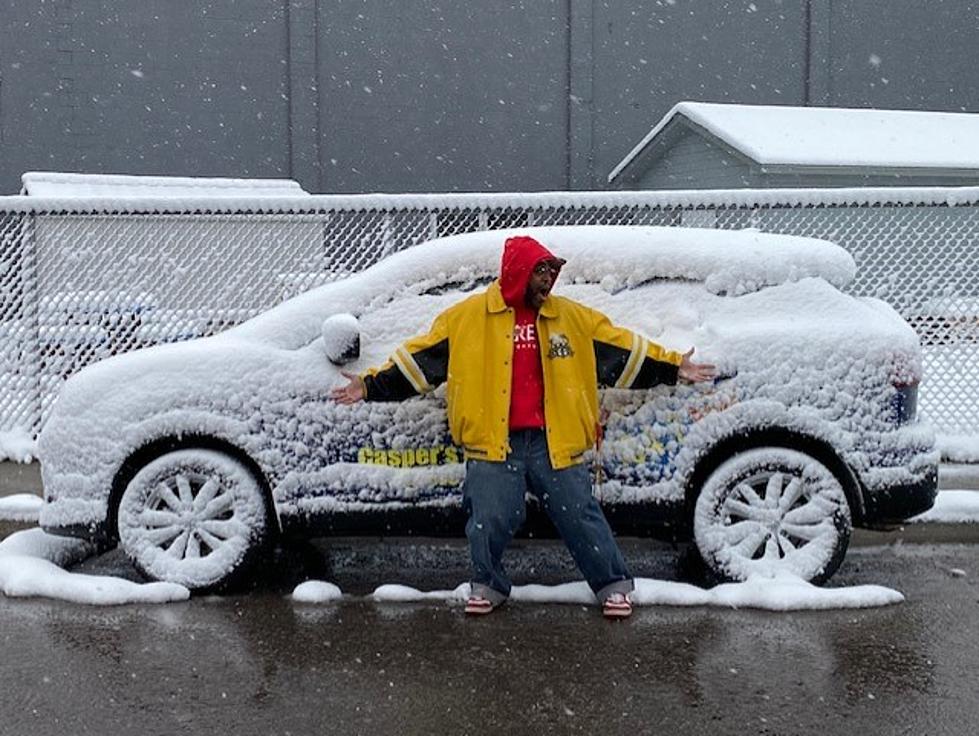
(OPINION) For the Love of Christmas, Stop Making Fruitcake
The views and opinions expressed in this article are those of the writer and do not necessarily reflect the views or positions of any entities with K2Radio News or Townsquare Media.
---
When I was a little kid, I always loved going to my grandparents’ house on Christmas. They pulled out all the stops.
In the morning me and the other kids would wake everyone up, running through the house like wild animals.
Brightly wrapped gifts spilled out from under the tree and onto every piece of furniture in the living room. We were lucky little people. Grandma had a giant black garbage bag on-the-ready for all the cardboard and plastic and paper that went flying through the air.
I still love Christmas. I do. I lovelovelove it. Especially re-creating some of those memories for my own small children. So don’t get me wrong. But…
As a grown-up, sometimes, it can feel like a month-long marathon of exhausting labor and excess spending leading up to an explosion that leaves everyone feeling vaguely sick.
Earlier this year, like last year and the year before, I set aside what I feel is a reasonable amount of money from my tax refund as my Christmas budget, and let’s be honest, I’ll probably end up spending even more once it’s all said and done because there’s always something or someone I forgot.
According to wealth experts, 1,000 bucks is the average most American households will spend, whether they’ve planned on it or not.
In 2020, holiday retail sales surpassed a trillion dollars—that’s twelve zeros! In 2014, the overall figure was just over 842 billion dollars, meaning that Christmas spending increased by over 160 billion dollars in less than five years! Between gifts, parties and decorations, the Christmas season in America seems to be getting more and more superfluous.
But on January 1st, if I don't get in front of this thing, I’ll check my bank statements, step on the scale, look around the house and feel a little guilty. Then I (and a legion of others) will plunge head-first into a deep pool of resolution in attempts to rectify the damage that’s been done and resolve to do things differently on the next go-round.
This year, as Christmas approaches, I consider how this holiday got so commercialized in the first place. If history is not your thing, skip to the end.
For nearly two millennia, people around the world have observed the holidays with practices that are both religious and even agrarian. In Scandinavia the Norse celebrated Yule from December 21st through January. Scholars say that the pagan Yule time included traditions of the Yule log, sitting by the fire with loved ones, feasting, and singing.

In fact, December was a perfect time for celebration in most areas of Europe, too, because that was the time when many of the animals were slaughtered. People would have had an abundance of fresh meat, and the wine and beer that was prepared earlier in the year was finally ready for drinking.
Sometime around the middle of the Nineteenth Century, modern Christmas, as we know it, was invented. A big driver in the spread of Christmas trees were women’s home magazines. Both the stories and the ads created Christmas lore that quickly became holiday mainstays.#trending
In Godey’s Lady’s Book, the most widely read magazine at the time, there’s a picture of Queen Victoria and her family gathered around a tree. “As with Dianna, Princess of Wales, and her hats, Queen Victoria started a lasting fad…in the English-speaking world,” says Karal Anne Marling, a professor of Art History and American Studies.
Around the same time, Charles Dickens, one of the most popular writers of the Victorian era created the much beloved tale of Ebenezer Scrooge. Dickens strongly detested industrialism and thought the modern world was becoming too cruel and that an obsession with money was preventing people from truly enjoying life.
Dickens was the first to teach us that true-gift giving shouldn’t derive from snooty pity but from an overflowing generosity. Yet by making gift-giving such a central part of his story, Dickens ironically “wedded Christmas to the very industrial, commercial world he despised.” said Marling.
Within Dickens’ own lifetime entrepreneurs began selling Christmas cards to create a market for the newly invented color printing technology, cementing symbols of Christmas like the tree, ornaments, Saint Nick and other figures into pop culture. With that, department stores began to stock ornaments in the same shapes they appeared in magazines and cards.
In 1862, Macy’s claims to have hosted the first real-live Santa, drawing in crowds of eager children with their parents and checkbooks following behind.
But the guy in the red coat who we know and love today wasn’t fully developed until the 1930’s when an illustrator named Haddon Sundblom was paid to craft an image of “a wholesome Santa” loosely based on Clement Clark Moore’s poem, “The Night Before Christmas…”
For Coca Cola advertisements.
Even Rudolph the red-nosed reindeer was created as a marketing strategy to boost holiday sales. A department store known as the Montgomery Ward commissioned a children’s rhyming book about the outcast reindeer that became an instant success, selling over two million copies the first year, and spawning the song and Claymation cartoon.
From Santa Claus and Rudolph the red-nosed reindeer to the iconic decorations of Christmas, marketing and business not only influenced our experience of the holiday season, it created it, and we bought it. We can trace the commercialization of Christmas back to the mid-1800s to see exactly how much marketing impacts our culture and, ultimately, the power of money over our social trends.
Whether you are religious or can just appreciate that the darkest days of winter will soon be over, might we do Christmas without the excess of food, presents and décor? Do we really need a bunch of sugar, jewelry and gadgets to put a smile on our loved ones’ faces?
I’m not suggesting we throw out all the commercial aspects of it. It is, after all, evident that Christmas spending is good for the economy. And sociologists tell us that reciprocity—giving and receiving— “is the life blood of any functioning society.”
That said, how long can we keep driving the expense and expectations up higher and higher?
Do we really need to spend $1000 a year on Christmas presents, or are we just perpetuating vapid trends? Is it really necessary to get your coworkers or that one random friend who always gets you a gift a gift? Where does it end?
I tend to agree with Dr. Seuss that Christmas will still come without “packages, boxes or bags. Maybe Christmas…doesn’t come from a store. Maybe Christmas, perhaps, means a little bit more”.
If this piece sent you into a rage and you now wish to find out where I live and eggnog my house: first–please don’t, second, this is just my humble opinion. If you share similar feelings about the holiday, here’s my tips:
Focus on gratitude for comfort and warmth. The Danes have a word called “hygge” (pronounced hoo-ga) that focuses on warmth, light, and enjoying the little things. They do this with candles, savory stews, warm socks, and cuddles. Although we don’t have a specefic word for it, I think we can still run with this sentiment.
Give generously to those who need it, not just to the people who expect it; and if you’re up for it, ask your loved ones to forgo getting you a present this year. You can always direct people to a charity of your choice if they insist.
READ ALSO: Casper Family Donates Dozens of Bags to 'Stuff the Van.'
Just cook what you need. Don’t give in to the urge to make ten different kinds of cookies that will inevitably go stale before they’re all eaten. By the way, nobody likes fruitcake; stop making fruitcake.
And finally, express joy and make laughter. Relax, unwind, and if you’re lucky enough to have time off from your job, appreciate it!
A Bosom Buddies Christmas Story
35th Annual Teddy Bear Tea in Downtown Casper
More From Wake Up Wyoming



![Casper Men: Can We Please Put the Toilet Seat Down? [OPINION]](http://townsquare.media/site/147/files/2020/05/Toilet-Bowl.jpg?w=980&q=75)

![Does Being Overly ‘Politically Correct’ Make Us Difficult To Entertain? [OPINION]](http://townsquare.media/site/147/files/2021/02/RS41692_GettyImages-924215138-scr.jpg?w=980&q=75)



